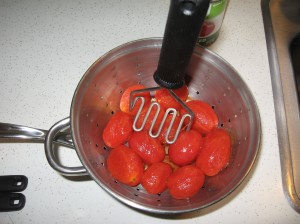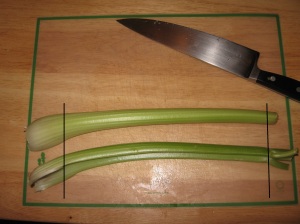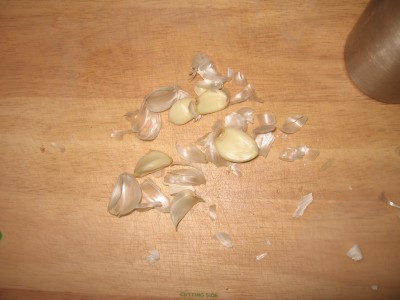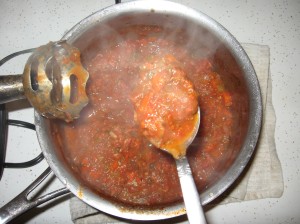He we are going to cover a recipe that can be expanded into a great deal of different dishes. In making these you will be able to learn some basic knife skills that will be able to carry you forward.
The recipe is for a basic tomato sauce. The tools that you will need:
Required: Knife; cutting board; skillet; sauce pot; colander
Optional: Stick Blender; Potato masher; vegetable peeler
Techniques learned: Basic knife skills
Recipe:
Ingredients
- 2 (28-ounce) cans whole, peeled tomatoes
- 1/4 cup sherry vinegar
- 1/4 cup sugar
- 1 teaspoon red pepper flakes
- 1 teaspoon dried oregano
- 1 teaspoon dried basil
- 1 onion
- 1 carrot
- 1 stalk celery
- 3 ounces olive oil
- 4 cloves garlic, minced
- 3 tablespoons capers, rinsed and drained
- 1/2 cup white wine
- Kosher salt and black pepper, to taste
Directions
In a sieve over a medium non-reactive saucepot, strain the tomatoes of their juice into the sauce pot.
Take your hands or potato masher and try to press out as much liquid from the tomatoes as you can.
Add the sherry vinegar, sugar, red pepper flakes, oregano, and basil to the tomato juice.
Stir and cook over high heat. Once bubbles begin to form on the surface, reduce to a simmer. Allow liquid to reduce by 1/2 or until liquid has thickened to a loose syrup consistency. About 20 minutes.
Cut carrot, onion, and celery into uniform sizes.
First take the onion and lay it on the cutting board. You are going to cut off the top of the onion and discard.
Now cut the onion in half across the vertical axis.

Peal the onion and carefully cut it down the middle while it is on its side.
Cut at least four vertical lines down the onion.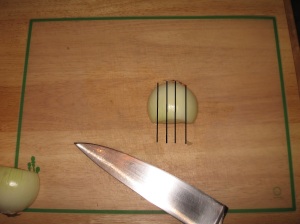
Turn and cut on the horizontal axis of the onion. This then produces a diced onion.
Now on to the celery. Cut off the tips and discard.
Cut them in half to a manageable size.
Next split them vertically down the middle.
Take the peaces and cut them horizontally to finish the dice.
Onto the carrots.
First peel the carrots with the knife or peeler.
Cut the ends of the carrot and discard. Also cut in half to a manageable size.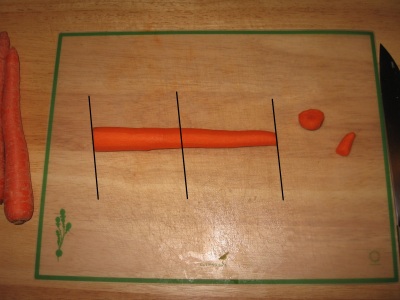
Cut the carrot in have vertically and then into three sections vertically.

Finally as with the celery cut horizontally to create the dice.
Lastly the garlic. First it must be peeled. To do this place it into a cup and shake the hell out of it. This will free up the skin from the garlic.
After shaking you can simply pick the cloves out.
The easiest way to prepare garlic is to put it on the cutting board. Place the side of the knife on top of the garlic and SMASH!
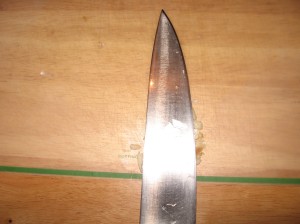


Now over medium-high heat warm the 3 ounces of olive oil in the skillet for about 3-4 minutes and then add the tomatoes.
Cook the tomatoes for 5-8 minutes or until they begin to change color. Stirring constantly. After that then add all of the vegetables and capers.
Continue cooking and stirring for 10 minutes or until everything takes on a richer darker color.
Add the tomato and vegetable mixture to the pot with the reduced liquid. Blend or crush to desired consistency and adjust seasoning.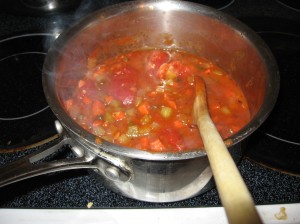
Crushed results.
Blended results.
Now there are many applications that this can be used with. You can simple add it to pasta in the crushed states. Ground meat can be add to make it a more filling sauce. You can blend it even more to use it as a marinara on a pizza. The choices are only limited to what you can think of, but it presents a starting point for many things.


